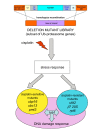Ubiquitin-proteasome genes as targets for modulation of cisplatin sensitivity in fission yeast
- PMID: 21247416
- PMCID: PMC3032702
- DOI: 10.1186/1471-2164-12-44
Ubiquitin-proteasome genes as targets for modulation of cisplatin sensitivity in fission yeast
Abstract
Background: The ubiquitin(Ub)-proteasome pathway is implicated in the regulation of a variety of cellular functions and plays a major role in stress response in eukaryotic cells, by targeting misfolded and damaged proteins for degradation. In addition, in the presence of DNA damage, the Ub-proteasome system regulates proteins involved in sensing, repairing, and/or tolerating the damage. Antitumor agents such as cisplatin can activate the pathway, but the role of specific pathway components in cell sensitivity/response to the drug is not known. Since platinum compounds represent clinically relevant antitumor agents and a major limitation to their use is the development of drug resistance, there is an urgent need for identifying targets for improving their efficacy.
Results: In the present study, we performed a genome-wide screening for sensitivity to cisplatin using non-essential haploid deletion mutants of the fission yeast Schizosaccharomyces pombe, belonging to a collection of haploid strains constructed through homologous recombination. Using this approach, we identified three Ub-proteasome mutants exhibiting hypersensitivity to cisplatin (ubp16, ubc13 and pmt3) and ten mutants (including ufd2, beta7 20S, rpt6/let1) resistant to the drug. In addition, the importance of lub1 gene emerged from the comparison between the present screening and gene expression profile data previously obtained in fission yeast.
Conclusions: The factors identified in the present study allowed us to highlight most finely the close relationship between the Ub-proteasome system and DNA damage response mechanisms, thus establishing a comprehensive framework of regulators likely relevant also in higher eukaryotes. Our results provide the proof of principle of the involvement of specific genes modulated by cisplatin treatment in cell response to the drug, suggesting their potential role as targets for modulating cisplatin sensitivity. In this regard, the prospective identification of novel targets for modulation of cisplatin sensitivity in an eukaryotic model organism appears particularly intriguing towards the discovery of strategies to overcome cisplatin resistance in human tumors.
Figures



Similar articles
-
Lub1 participates in ubiquitin homeostasis and stress response via maintenance of cellular ubiquitin contents in fission yeast.Mol Cell Biol. 2004 Mar;24(6):2324-31. doi: 10.1128/MCB.24.6.2324-2331.2004. Mol Cell Biol. 2004. PMID: 14993272 Free PMC article.
-
Nuclear protein quality is regulated by the ubiquitin-proteasome system through the activity of Ubc4 and San1 in fission yeast.J Biol Chem. 2011 Apr 15;286(15):13775-90. doi: 10.1074/jbc.M110.169953. Epub 2011 Feb 15. J Biol Chem. 2011. PMID: 21324894 Free PMC article.
-
The fission yeast ubiquitin-conjugating enzymes UbcP3, Ubc15, and Rhp6 affect transcriptional silencing of the mating-type region.Eukaryot Cell. 2002 Aug;1(4):613-25. doi: 10.1128/EC.1.4.613-625.2002. Eukaryot Cell. 2002. PMID: 12456009 Free PMC article.
-
UBA domain containing proteins in fission yeast.Int J Biochem Cell Biol. 2003 May;35(5):629-36. doi: 10.1016/s1357-2725(02)00393-x. Int J Biochem Cell Biol. 2003. PMID: 12672455 Review.
-
[How does fission yeast cut8 regulate the nuclear localization of proteasome?].Tanpakushitsu Kakusan Koso. 2006 Aug;51(10 Suppl):1241-4. Tanpakushitsu Kakusan Koso. 2006. PMID: 16922381 Review. Japanese. No abstract available.
Cited by
-
Determination of differentially regulated proteins upon proteasome inhibition in AML cell lines by the combination of large-scale and targeted quantitative proteomics.Proteomics. 2017 Apr;17(7):1600089. doi: 10.1002/pmic.201600089. Epub 2016 Dec 21. Proteomics. 2017. PMID: 27709814 Free PMC article.
-
PID1 increases chemotherapy-induced apoptosis in medulloblastoma and glioblastoma cells in a manner that involves NFκB.Sci Rep. 2017 Apr 11;7(1):835. doi: 10.1038/s41598-017-00947-6. Sci Rep. 2017. PMID: 28400607 Free PMC article.
-
Systems biology of cisplatin resistance: past, present and future.Cell Death Dis. 2014 May 29;5(5):e1257. doi: 10.1038/cddis.2013.428. Cell Death Dis. 2014. PMID: 24874729 Free PMC article. Review.
-
ABT-737 Synergizes with Cisplatin Bypassing Aberration of Apoptotic Pathway in Non-small Cell Lung Cancer.Neoplasia. 2017 Apr;19(4):354-363. doi: 10.1016/j.neo.2017.02.008. Epub 2017 Mar 17. Neoplasia. 2017. PMID: 28319809 Free PMC article.
-
The Ubiquitin ligase Ubr11 is essential for oligopeptide utilization in the fission yeast Schizosaccharomyces pombe.Eukaryot Cell. 2012 Mar;11(3):302-10. doi: 10.1128/EC.05253-11. Epub 2012 Jan 6. Eukaryot Cell. 2012. PMID: 22226946 Free PMC article.
References
-
- Perego P, Jimenez GS, Gatti L, Howell SB, Zunino F. Yeast mutants as a model system for identification of determinants of chemosensitivity. Pharmacol Rev. 2000;52:477–492. - PubMed
Publication types
MeSH terms
Substances
Grants and funding
LinkOut - more resources
Full Text Sources
Molecular Biology Databases

